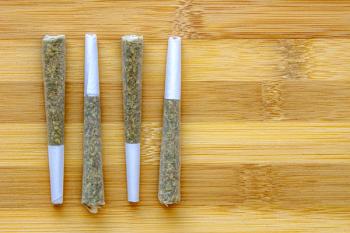
Cannabis Science and Technology
- July/August 2019
- Volume 2
- Issue 4
Solubilization of Phytocannabinoids Using Cyclodextrins
This article reviews state-of-the-art approaches to produce cyclodextrinphytocannabinoid complexes, related processing and analytical techniques, and implications for cannabis product development.
Abstract / Synopsis:
Two major active components of cannabis, cannabidiol (CBD) and tetrahydrocannabinol (THC), as well as minor cannabinoids and associated terpenes, are very poorly soluble in water. This property of cannabis presents major problems for product design and formulation that are difficult to overcome. One of the strategies for effective solubilization is based on using cyclodextrins (CD) that are cyclic polysaccharides capable of forming inclusion complexes with hydrophobic molecules. Cyclodextrins are considered generally recognized as safe (GRAS) by the U.S. Food and Drug Administration (FDA) and have been widely used in food, personal care, and pharmaceutical applications. This article reviews state-of-the-art approaches to produce CD-phytocannabinoid complexes, related processing and analytical techniques, and implications for cannabis product development. Continued interest for improved water solubility has been dictated by both highly desirable improvements in low and variable bioavailability of phytocannabinoids as well as development of better end user experience (such as taste, ease and convenience of use, better shelf product stability, and so on). Thus, the supply of liquid ingredients will be critically important for the rapidly expanding scope of novel consumer products for the recreational use, cannabis-enriched food, food additives, and personal care markets.
Solubility of tetrahydrocannabinol (THC) in water is so low that traditional direct methods were found unusable for accurate measurements (1). THC solubility estimates were derived from the more soluble water–ethanol mixtures with variable ethanol content, by the linear extrapolation of the 240 nm ultraviolet (UV) band for 5–15% ethanol solution to 100% aqueous. This classical experiment produced an often-cited THC solubility value of 2.8 µg/mL at 23 °C that gets further reduced (almost to a quarter of that number) by desalting effects, to 0.77 µg/mL, in 0.15 M NaCl. The water solubility of CBD falls in the same low range and has been reported at 0.1 µg/mL (2).
Historical recreational use of phytocannabinoids has been almost exclusively limited to inhalation of the cannabis-derived smoke or concentrate’s vapors. So the first phytocannabinoids solubilization approaches came mostly from pharmaceutical development and relied on using alcohol or oil mixtures (solubility enhancement enabling concentrations >100 mg/mL). These found use in Marinol softgel capsules of THC (glycerol and sesame oil), oromucosal Sativex THC–cannabidiol (CBD) spray (ethanol, propylene glycol, and peppermint oil), and recently the U.S. Food and Drug Administration (FDA)-approved orally administered CBD liquid dose of Epidiolex (ethanol and sesame oil; recommended doses as high as >5 mg/kg).
Complexation with cyclodextrins (CDs) has several important benefits when compared to other solubilization approaches. Cyclodextrins keep the active molecules solubilized at high dilutions without precipitation and helps to avoid using organic solvents, surfactants, emulsifiers, and other polymeric additives. This process therefore reduces toxicological concerns and offers simple production options (3).
Cyclodextrins form a toroid (truncated conical) configuration with multiple hydroxyl groups at each side and a lipophilic inner cavity. Their interactions with hydrophobic substrates are often described within a concept of the noncovalent “host–guest” complexes, optimization of the hydrophobic interactions, and the best spatial fit of the substrate in the available binding pocket of the ligand. The cyclodextrin solubility in water at 25 °C differs considerably, with γ-cyclodextrin being the most soluble (0.249 g/mL) followed by α-cyclodextrin (0.184 g/mL) and β-cyclodextrin (0.12 g/mL) (4). Typical cyclodextrins contain six to eight glucose monomer units. The rings are cone-shaped with a cavity depth of ~0.7–0.8 nm and cavity diameter of ~0.5–0.8 nm. Molecules with larger rings have also been made, but so far remain primarily in the realm of academic research. As an example, Figure 1 shows the chemical and crystallographic structures of β-cyclodextrins (5). (See upper right for Figure 1, click to enlarge.) Solvent molecules are easily drawn into the inner cavity and bind outside via hydrogen bonding giving rise to various clathrate structures, which are particularly plentiful with water.
Discussion
Supply and Derivatives
CDs are commercially manufactured from starch, by its treatment with two key enzymes, amylase and cyclodextrin glucosyltransferase. The use of CDs has continued to grow across the industries to an estimated >400,000 metric tons in 2016, with food grade materials costing $50–400/kg. The most common CD derivatives are shown in Figure 2. (See upper right for Figure 2, click to enlarge.)
Post-processing chemical modifications (usually, alkylation or acylation of the hydroxy groups, with variable numbers of molar substitutions per sugar unit, 0.5–2) provide access to adjusting the solubility profile of cyclodextrins. One of the biggest suppliers of high quality materials (including pharma grades) worldwide is Wacker Chemie that distributes and supports the products in the U.S. market via Ashland Group under the trademarks CAVITRON, CAVAMAX, and CAVASOL.
As an example of an inclusion complex with higher bioavailability, Wacker sells a dietary supplement product CAVACURMIN that is a 1:1 complex of curcumin with γ-CD. This material showed a 40-fold improved bioavailability compared to unformulated curcumin in small human clinical trials (6). Structurally similar 2-hydroxypropyl modified (2-HP-β-CD) and native beta-cyclodextrins are offered by the French agro conglomerate Roquette under the brand name KLEPTOSE. CAPTISOL brand by Cedex Pharmaceuticals is sulfobutylether (SBE) anionic derivative of β-CD with enhanced (>50x) solubility in water compared to native material.
Both European and United States Pharmacopoeias include three parent CDs and two synthetic derivatives, 2-HP-β-CD and SBE-β-CD-Na+ that are more water-soluble variants. Two other CD derivatives are approved as excipients in human pharmaceutical products, larger ring 2-HP-γ-CD and more hydrophobic randomly methylated-β-CD (Me-β-CD). About 35 pharmaceutical formulations that contain cyclodextrins on the ingredients list are currently in the marketplace with β-CD and 2-HP-β-CD at the top of the list (3).
Characterization and Optimization of the CD Complexes
Formation of the CD complexes has been typically studied by constructing related substrate-ligand phase solubility Higuchi-Connors diagrams (7) (more accessible analyses may be found in many contemporary surveys, such as one found in the literature [8]) that would plot substrate solubility versus CD concentration (Figure 3). (See upper right for Figure 3, click to enlarge.) Such experiments include adding an excess amount of substrate to aqueous CD solution of variable concentration, incubation with shaking for 1–2 h, followed by filtration of the unbound substrate. The stability constant K and complexation efficiency (CE) of the inclusion complex are then calculated from the slope of the phase solubility diagrams as follows:
K = slope/S0(1-slope) [1]
CE = slope/(1-slope) [2]
where S0 is the equilibrium substrate solubility in water without CD. CE represents a concentration ratio between cyclodextrin in a complex and free cyclodextrin.
In most cases, the results of solubility studies are interpreted as formation of either 1:1 or 2:1 CD-to-substrate complexes. In recent years, however, this simplified picture has been complemented with growing evidence of existing larger assemblies including homo- and hetero-aggregates, micellar structures, non-inclusion complexes, and so forth (8). For all practical purposes, initial solubility screening studies that test a standard panel of commercially available CDs appear to be a good paradigm to begin product development. Besides solubility testing explored by ultraviolet-visible (UV-vis) spectroscopy or high performance liquid chromatography (HPLC), formation of the CD complexes could be conclusively confirmed by differential scanning calorimetry (DSC) and qualitatively characterized by optical microscopy as well as other methods (9). Nuclear magnetic resonance (NMR) and infrared (IR) spectroscopy (Job’s titration plots) could sometimes be helpful but may be harder to interpret quantitatively because of signal overlaps and only minor shifts upon complexation.
A number of practical tips on the rapid assessment of solubility regarding effective experimental designs have been reported by Loftsson and colleagues (10). An important observation derived from their comprehensive commercial drug screening program revealed that for poorly soluble active pharmaceutical ingredients (<30 µg/mL), there are substantial negative deviations of the extrapolated (to the nil CD concentration) solubility value St from dissolution diagrams compared to the intrinsic solubility S0. The origins of this phenomenon are still poorly understood. But the slope-only dependent parameter CE, rather than a stability constant K calculated from S0, now appears as a much more practically relevant estimate. So we should be putting more emphasis on CE when looking at phytocannabinoids.
CD Complexes with Phytocannabinoids
Most of the information we have about cyclodextrin complexes of phytocannabinoids were collected in a few investigations conducted in the mid-2000s. This work identified optimal cyclodextrins with better binding properties and provided some proof-of-principle animal data to illustrate possible utility compared to unbound materials. Among the later work, US patent WO 2017/183011 describes the formation of β-CD and 2-HP-β-CD complexes of THC and CBD that were obtained by the melt/no-solvent method and with addition of propylene glycol (11). It claimed improved water solubility of the resulting products. However, the patent provided little characterization of the CD-encapsulated cannabinoids.
Widely quoted publications by Mannila and colleagues (2,12) reported several cyclodextrin complexes of THC-9 and CBD, including 2-HP-β-CD, Me-β-CD, and β-CD. The related binding constants and complexation efficiencies are presented in Table I. (See upper right for Table I, click to enlarge.) Me-β-CD and β-CD emerged as far better ligands compared to 2-HP-β-CD. Comparable results have been obtained in the studies reported by Hazekamp and colleagues (13) that investigated α-, β-, γ-, and Me-β-CD complexation by THC-9. A THC-9 concentration of about 14 mg/mL was reached by using 24% (~0.2 M) Me-β-CD solution, which amounts to an increase in solubility of four orders of magnitude. The deviation from linearity and realization of the AP type of the phase solubility diagrams has been interpreted as possible formation of the high order complexes, however, one group proposed a 1:2 THC-to-CD stoichiometry (12), whereas other investigators (13) favored 2:1 ratio with an out-of-cavity binding mode of the second cannabinoid molecule. The 1:2 THC-to-CD complex has been isolated by the precipitation method. Future X-ray crystallography studies may help to resolve the question and establish an exact binding mode for both THC and CBD ligands. Complexation preferences of THC-8 and binding constants were found to be analogous to THC-9 (14) though the total solubility was lower (Table I).
Production Methods and Process Economics
Cyclodextrin inclusion complexes can be prepared by several methods such as kneading, common solvent evaporation, coprecipitation, and freeze-drying methods (3). Most of the published cannabinoid pilot work used freeze-drying methods in which the alcohol solution of the substrate was added to the concentrated aqueous CD solutions and the solvents were removed by freeze-drying. However, it may be not an optimal scale up production method. From an energy saving perspective, kneading and precipitation appear to be superior methods. As this point, the reports on the commercially relevant phytocannabinoid encapsulation technologies are still lacking.
Enabling Better Drug Delivery
Dissolution experiments are a strong predictor of the drugs performance in the living systems. Faster dissolution kinetics have been strongly correlated with better bioaviability for the highly lipophilic and poorly soluble drugs. Though a potential of the phytocannabinoid CD complexes has never been explored in human clinical trials, available in vitro and animal data may support improved delivery. The idealized phytocannabinoid in vitro dissolution curves are presented in Figure 4. (See upper right for Figure 4, click to enlarge.) Apparently, complexation with CDs allowed for reducing the dissolution time to just a few minutes. Consequently, pharmacologically relevant superior outcomes have been obtained in several studies. The rabbit in-vivo model showed comparable area-under-the curve (AUC) numbers achieved between sublingual ethanolic CBD solutions and sublingual CBD-Me-β-CD complex, whereas oral administration of CBD revealed no quantifiable parent molecules in plasma at any time point (2). In an ex-vivo study, a transcorneal permeation of THC-8 could only be achieved with an addition of cyclodextrins to the formulations (14).
Increased Stability
Complexation with CD was universally found to stabilize phytocannabinoids. The early data (15) were fully supported by subsequent studies. THC-9 complexes with Me-β-CD displayed no degradation in water solutions in the range of pH 5–9 for 8 weeks at ambient temperature (13). In similar conditions, including more detrimental acidic, THC-8 aqueous solutions containing 5% ethanol and 5% cyclodextrin showed no degradation with an addition of Me-β-CD and SPE-β-CD and significantly slowed degradation for 2-HP-β-CD (14).
Conclusions
There are some proof-of-principle published data indicating efficient encapsulation of phytocannabinoids into cyclodextrin complexes with enhanced solubility. A small range of in vivo animal data support a notion that such complexes may have better pharmacological properties than unbound materials. Successful development of multiple pharmaceutical and nutritional products already in the market place leads us to believe that using CD complexation of phytocannabinoids may be beneficial.
Possible improvements in stability and taste control or masking are the areas that have not been investigated in much detail so far, but clearly represent a growing industry need. Cyclodextrin complexes may also be useful in helping to capture more elusive “entourage effects” by virtue of concurrent complexation of the contributing terpenes, polyphenols, and other minor components in natural cannabis and hemp isolates (16).
Further structural and process optimization along with development of the viable and economical production scale up methods seems to be logical next steps to consider for cannabis technologists. If taken, it would enable a strong feedback loop to the extended animal and human testing and new product prototype development both for the consumer markets and medical applications.
References:
- E.R. Garrett and C.A. Hunt, J. Pharm. Sc. 63(7), 1059–1063 (1974).
- J. Mannila, T. Järvinen, K. Järvinen, and P. Jarho, J. Pharm. Sci. 96(2), 312–319 (2007).
- S. Jacob and A. Nair, Drug Dev. Res. 79, 201–217 (2018).
- E. Sabadini, T. Cosgrove, and C. and Fdo Egídio, Carbohyd. Res. 341, 270–274 (2006).
- T. Steiner and G. Koellner, J. Am. Chem. Soc. 116, 5122 (1994).
- M. Purpura, R.P. Lowery, J.M. Wilson, H. Mannan, G. Münch, and V. Razmovski Naumovski, Eur. J. Nutr. 57(3), 929–938 (2017).
- T. Higuchi and K.A. Connors, in Adv. Anal. Chem. Instrum. 4, 117–212 (1965).
- T. Loftsson, P. Jarho, M. Másson, and T. Järvinen, Expert Opin. Drug Del. 2, 335–351 (2005).
- P. Mura, J. Pharm. Biomed. Anal. 113, 226–238 (2014).
- T. Loftsson, D. Hreinsdottir, and M. Másson, Int. J. Pharm. 302, 18–28 (2005).
- U.S. Patent, WO 2017/183011 Al (2017), “Water-soluble cannabinoid inclusion complexes.”
- J. Mannila, T. Järvinen, K. Järvinen, M. Tarvainen, and P. Jarho, Eur. J. Pharm. Sci. 26, 71–77 (2005).
- A. Hazekamp and R. Verpoorte, Eur. J. Pharm. Sc. 29, 340–347 (2006).
- K. Hippalgaonkar, W. Gul, M.A. ElSohly, M.A. Repka, and S. Majumdar, AAPS PharmSciTech 12(2), 723–731 (2011).
- Y. Shoyama, S. Morimoto, and I. Nishioka, J. Nat. Prod. 46(5), 633–637 (1983).
- J. Lou, Z. Teng, L. Zhang, J. Yang, L. Ma, F. Wang, X. Tian, R. An, M. Yang, Q. Zhang, L. Xu, and Z. Dong, Front. Pharmacol. 8, 1–16 (2017).
Alex Nivorozhkin, PhD, is an Adjunct Professor at the Center for Drug Discovery at Northeastern University in Boston, Massachusetts where his interests are focused on the translational research related to new drugs targeting the endocannabinoid system. Alex is a principal in several biotech and phytocannabinoid startup companies and an expert consultant to the cannabis industry in the area of drug formulation and drug delivery. Direct correspondence to:
How to Cite This Article
A. Nivorozhkin, Cannabis Science and Technology 2(4), 58-64 (2019).
Articles in this issue
over 6 years ago
Microbiological Attributes of Cannabis-Derived Productsover 6 years ago
The Keys to Clean Cannabisover 6 years ago
The What, How, and Why of Water Activity in Cannabisover 6 years ago
Cannabis Is Medicine . . . Test It like MedicineNewsletter
Unlock the latest breakthroughs in cannabis science—subscribe now to get expert insights, research, and industry updates delivered to your inbox.




